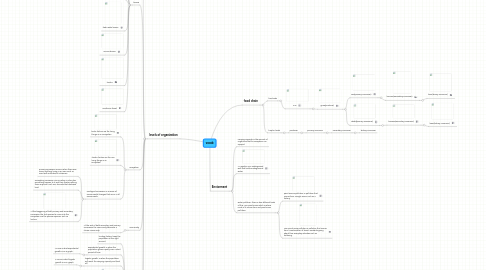
1. levels of organization
1.1. biosphere
1.2. biome
1.2.1. rainforest
1.2.2. temperate decidious forest
1.2.3. desert
1.2.4. grasslands/savannah
1.2.5. fresh water biome
1.2.6. marine biome
1.2.7. tundra
1.2.8. coniferous forest
1.3. ecosystem
1.3.1. biotic factors are the living things in an ecosystem
1.3.2. Abiotic factors are the non living things in an ecosystem
1.3.3. ecological succession is a series of enviormental changes that occur in all enviorments
1.3.3.1. primary succession occurrs when there was never anything living in an area, such as new land and sides of volcanoes
1.3.3.2. Secondary succession occurrs when a place has something happen to it and then theres nothing there anymore, such as a tornado that destroies land.
1.3.3.3. At the beggining of both primary and secondary succession the first species to move into the ecosystem are the pioneer species, such as linches.
1.4. community
1.4.1. At the end of both secondary and primary succession the community becomes a climax community.
1.5. population
1.5.1. limiting factors, keep the population at the right amount.
1.5.2. expodential growth, is when the population grows rapidly over a short period of time.
1.5.2.1. J-curve is what expodential growth is on a graph.
1.5.3. logistic growth, is when the population will reach the carrying capacity and level off
1.5.3.1. S-curve is what logistic growth is a on graph.
1.5.4. Black plegue was the largest decrease in population
1.5.5. industrial revolution helped the population grow becasue it gave them better medicine, and better sanitation
1.5.6. population growth
1.5.6.1. limiting factors control population growth so it doesnt increas to much, it keeps it at the right amount.
1.5.7. population growth rate, the rate at which the population grows. africa has the highest population growth rate.
1.5.8. hot spots, are areas on Earth that are very highly populated.
1.5.9. sustainibiliy is how biological systems remain diverse and productive over time.
1.6. organism
1.6.1. biodiversity is the variety of organisms in a geographic area.
2. food chain
2.1. food web
2.1.1. sun
2.1.1.1. grass(producer)
2.1.1.1.1. cow(primary consumer)
2.1.1.1.2. rabbit(primary consumer)
2.2. trophic levels
2.2.1. producer
2.2.1.1. primary consumer
2.2.1.1.1. secondary consumer
3. Enviorment
3.1. carrying capacity, is the amount of organisms that an ecosystem can support
3.2. An aquifer is an underground well that holds undergrround water.
3.3. water pollution, there is two different kinds of this, non-point sorce which is where most of it comes from and point sorce pollution.
3.3.1. point source pollution, is pollution that comes from a single sorce, such as a factory.
3.3.2. Non-point sorce pollution is pollution that comes from a combination of town's residents going about thier everyday activities such as fertilizing.
